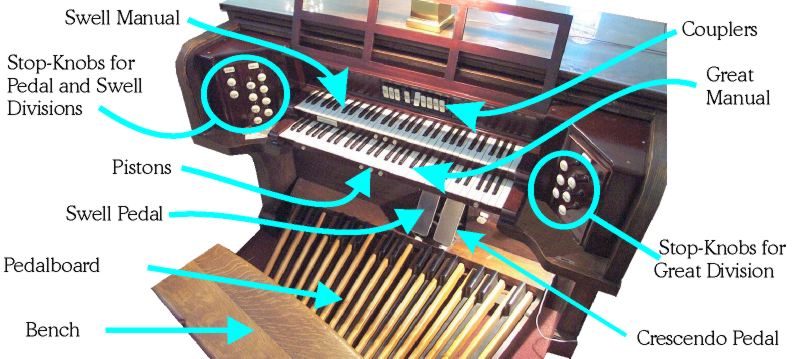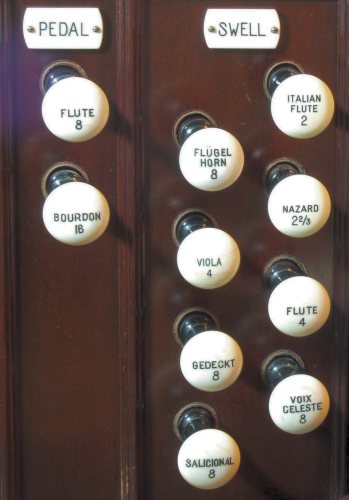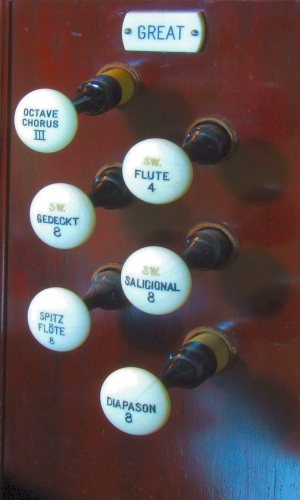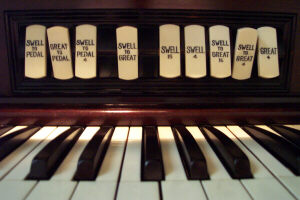The Organ at High Street: Console

|
The above diagram labels various parts of the organ's console.
There are two keyboards, called "manuals". The top keyboard is called the swell manual; from it the pipes in the swell division are played. Below the swell manual is the great manual. The pipes from the great division, which includes the pipes seen from the sanctuary, are played from this keyboard. Perhaps the most fun-to-play keyboard is the one played by the organist's feet: the pedalboard. The pedal division of the High Street organ has two stops, the pipes of which provide the deepest, lowest notes. Typically, the organist plays the bass line of a hymn with his/her feet, leaving the upper three parts (tenor, alto and soprano) for the hands. |

Some swell division pipes. |

|
Series of stop-knobs on either side of the manuals
are used by the organist to control which sets
of pipes are to sound when the keys are played.
These knobs are just big on/off switches: pull the knob out
and the corresponding pipes are ready for action.
On the left are the stop-knobs for the pedal and swell pipes. On each knob is engraved the name of the stop, and a number. The name is a description of the type of sound offered by the pipes of that stop, and the number has to do with the stop's pitches, which we'll explain below. On the right are the stops for the great division. Two of these stops (the "Octave Chorus" and the "Diapason") have been "drawn" - that is, pulled out. They are now ready to sound when the keys on the great manual are played. Although it appears there are six stops for the great division, three of them are actually "borrowed" from the swell, and are marked as such. |

|
These numbers are refered to as "footages", and there is a correspondence between the number and the length of the longest pipe of that stop: Typically (but not always, for technical reasons) the longest pipe of a stop marked "8" is indeed about 8 feet long. We refer to such a pipe as an 8-foot, or 8', stop.
Thanks to the generous and supportive congregation at High Street, we now have a 2' stop on the organ, the "Italian Flute". Normally not ever used by itself as a solo stop, its purpose is to add a distinct brightness to the sound played together with other stops in various combinations. One of my favorite such combinations is 8' Gedeckt + 2' Italian Flute, for example.
It was Will Bredenberg's suggestion to add a Nazard 2 2/3' stop, when the organ was originally installed at High Street. This terrific stop speaks one-and-one half octaves higher than the normal 8' stops. For example, when you play this stop by itself on middle C, the note you hear is actually the G an octave and a half higher. Normally, this stop is never used all by itself, but always together with some other stops. The result is simply, well, gorgeous. (And when coupled to the great with the octave-coupler, the added sheen is stunning.)
One of our pedal stops is marked "16"; these pipes speak an octave lower than the 8' stops. They produce the deepest pitches of the organ. The longest pipes are actually only about 8' long, but caps on their tops force them to speak an octave lower - it's a physics thing!
Really big organs may have 32' stops, with the biggest pipes actually around 32 feet tall.
 Briefly: the couplers are on/off switches
that allow the pipes from one division
of the organ to be played on other keyboards.
For example, in this photo,
the
coupler "Great to Pedal" is activated. This means whatever
great-stops are drawn (or pulled "on") will play on both the
great-manual and the pedal board as well.
Another activated coupler is marked "Swell to Great 4".
This means that
the swell stops which have been drawn will also play
from the great-manual,
but, one octave higher. It's as though the organist has
a pair of invisible hands ready to play
along on the swell manual one octave higher.
Briefly: the couplers are on/off switches
that allow the pipes from one division
of the organ to be played on other keyboards.
For example, in this photo,
the
coupler "Great to Pedal" is activated. This means whatever
great-stops are drawn (or pulled "on") will play on both the
great-manual and the pedal board as well.
Another activated coupler is marked "Swell to Great 4".
This means that
the swell stops which have been drawn will also play
from the great-manual,
but, one octave higher. It's as though the organist has
a pair of invisible hands ready to play
along on the swell manual one octave higher.
There are two "gas pedals": The left pedal is the swell-pedal. It opens the shutters in the swell box, letting more sound out, and increasing the apparent loudness of the swell pipes. The right hand pedal is the crescendo-pedal. As it is pushed forward, more and more stops are activated, from the quietest to the loudest.
Pistons are little buttons under the keys that when pressed, automatically pull out some stops and push in others. In this way the organist can instantly change the sound of the organ with a push of the thumb. The pistons are "programmable" in that the organist can set them to control any desired combination of stops.
|
Return to Chip's Home Page
Return to High Street Organ Main Page |
© 2009 by Chip Ross Associate Professor of Mathematics Bates College Lewiston, ME 04240 |